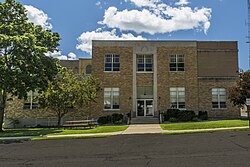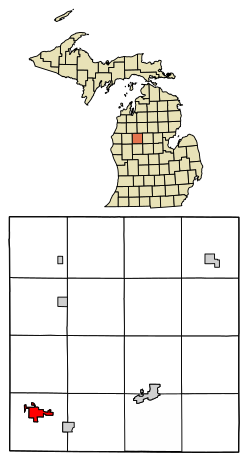Reed City, Michigan
Reed City, Michigan | |
|---|---|
 Osceola County Courthouse | |
| Motto: Your Crossroads Community on the Path to Progress... | |
 Location of Reed City, Michigan | |
| Coordinates: 43°52.5′N 85°30.6′W / 43.8750°N 85.5100°W | |
| Country | United States |
| State | Michigan |
| County | Osceola |
| Area | |
| • Total | 2.13 sq mi (5.53 km2) |
| • Land | 2.10 sq mi (5.44 km2) |
| • Water | 0.03 sq mi (0.09 km2) |
| Elevation | 1,040 ft (317 m) |
| Population (2020) | |
| • Total | 2,490 |
| • Density | 1,184.59/sq mi (457.32/km2) |
| Time zone | UTC-5 (Eastern (EST)) |
| • Summer (DST) | UTC-4 (EDT) |
| ZIP code | 49677 |
| Area code | 231 |
| FIPS code | 26-67820[2] |
| GNIS feature ID | 1621363[3] |
Reed City is a city in the U.S. state of Michigan. The population was 2,490 at the 2020 census. It is located in southwestern Osceola County and is the county seat.[4]
Geography[edit]
According to the United States Census Bureau, the city has a total area of 2.11 square miles (5.46 km2), of which 2.08 square miles (5.39 km2) is land and 0.03 square miles (0.08 km2) is water.[5]
The Hersey River flows through Reed City.
Demographics[edit]
| Census | Pop. | Note | %± |
|---|---|---|---|
| 1880 | 1,091 | — | |
| 1890 | 1,776 | 62.8% | |
| 1900 | 2,051 | 15.5% | |
| 1910 | 1,690 | −17.6% | |
| 1920 | 1,803 | 6.7% | |
| 1930 | 1,792 | −0.6% | |
| 1940 | 1,845 | 3.0% | |
| 1950 | 2,241 | 21.5% | |
| 1960 | 2,184 | −2.5% | |
| 1970 | 2,286 | 4.7% | |
| 1980 | 2,221 | −2.8% | |
| 1990 | 2,379 | 7.1% | |
| 2000 | 2,430 | 2.1% | |
| 2010 | 2,425 | −0.2% | |
| 2020 | 2,490 | 2.7% | |
| U.S. Decennial Census[6] | |||
2020 census[edit]
At the 2020 census there were 2,465 people. The population density was 1,172.6 per square mile (452.7/km2).
2010 census[edit]
At the 2010 census,[7] there were 2,425 people, 1,007 households, and 582 families living in the city. The population density was 1,165.9 per square mile (450.2/km2). There were 1,136 housing units at an average density of 546.2 per square mile (210.9/km2). The racial make-up of the city was 94.8% White, 1.7% African American, 0.5% Native American, 0.2% Asian, 0.3% from other races and 2.5% from two or more races. Hispanic or Latino of any race were 2.2% of the population.
There were 1,007 households, of which 33.3% had children under the age of 18 living with them, 35.3% were married couples living together, 16.8% had a female householder with no husband present, 5.8% had a male householder with no wife present, and 42.2% were non-families. 38.7% of all households were made up of individuals, and 15.6% had someone living alone who was 65 years of age or older. The average household size was 2.26 and the average family size was 2.98.
The median age was 36.1 years. 26.4% of residents were under the age of 18, 9.6% were between the ages of 18 and 24, 25.1% were from 25 to 44, 21.4% were from 45 to 64 and 17.5% were 65 years of age or older. The sex make-up of the city was 44.9% male and 55.1% female.
2000 census[edit]
At the 2000 census,[2] there were 2,430 people, 999 households and 609 families living in the city. The population density was 1,265.3 per square mile (488.5/km2). There were 1,090 housing units at an average density of 567.5 per square mile (219.1/km2). The racial make-up was 95.84% White, 1.07% African American, 0.74% Native American, 0.21% Asian, 0.12% from other races, and 2.02% from two or more races. Hispanic or Latino of any race were 0.91% of the population.
There were 999 households, of which 31.2% had children under the age of 18 living with them, 40.2% were married couples living together, 16.4% had a female householder with no husband present, and 39.0% were non-families. 33.4% of all households were made up of individuals, and 14.4% had someone living alone who was 65 years of age or older. The average household size was 2.30 and the average family size was 2.93.
25.6% of the population were under the age of 18, 11.4% from 18 to 24, 25.4% from 25 to 44, 19.8% from 45 to 64 and 17.7% were 65 years of age or older. The median age was 36 years. For every 100 females, there were 84.2 males. For every 100 females age 18 and over, there were 80.8 males.
The median household income was $30,756 and the median family income was $42,340. Males had a median income of $29,375 and females $25,263. The per capita income was $15,889. About 10.9% of families and 17.9% of the population were below the poverty line, including 16.6% of those under age 18 and 14.2% of those age 65 or over.
Infrastructure[edit]
Transportation[edit]
The city is also at the crossroads of two US highways:
 US 10 is a highway that goes by Reed City. It has a business route that goes through the city.
US 10 is a highway that goes by Reed City. It has a business route that goes through the city.
 Bus. US 10 is the only highway that goes directly into Reed City. Most of the business of Reed City are along Bus. US 10.
Bus. US 10 is the only highway that goes directly into Reed City. Most of the business of Reed City are along Bus. US 10. US 131 is a freeway that junctions US 10 near Reed City.
US 131 is a freeway that junctions US 10 near Reed City.
Indian Trails provides daily intercity bus service between Grand Rapids and Petoskey, Michigan.[8]
Two of the state's premier rail trails intersect in the city:
Historical transportation[edit]
The Pennsylvania Railroad ran trains from Grand Rapids to Cadillac, Petoskey and Mackinaw City on a route that includes land used now for the White Pine Trail, making stops in Reed City's union station. Immediate connections in Grand Rapids with sleepers to eastern Indiana and Cincinnati were part of the schedule. Reed City was the closest PRR station to Idlewild, a significant African-American resort until the 1960s. In the final years, service through the town was reduced to summer only.[9] Passenger service ended between 1954 and 1955.[10]
The Pere Marquette Railway ran trains west from Reed City to Ludington and east to Saginaw, on a route that is included in the above cited rail trail. At Saginaw the trains were timed to meet with separate Bay City-originating trains to Detroit. The PM's successor, the Chesapeake and Ohio Railway, ended the Ludington to Saginaw trains in the latter months of 1949.[11]
Notable people[edit]
- George Bennard, American composer and preacher best known for composing the hymn, "The Old Rugged Cross". Bennard retired to Reed City, where he died on October 10, 1958.
- Harold Cronk, American writer and director
- William C. Giese, member of the Wisconsin State Assembly and educator, was born in Reed City on April 18, 1886.[12]
- Thomas D. Schall, U.S. representative from Minnesota's 10th congressional district (1915–1925) and U.S. senator from Minnesota (1925–1935), was born in Reed City on June 4, 1878.
References[edit]
- ^ "2020 U.S. Gazetteer Files". United States Census Bureau. Retrieved May 21, 2022.
- ^ a b "U.S. Census website". United States Census Bureau. Retrieved January 31, 2008.
- ^ "US Board on Geographic Names". United States Geological Survey. October 25, 2007. Retrieved January 31, 2008.
- ^ "Find a County". National Association of Counties. Retrieved June 7, 2011.
- ^ "US Gazetteer files 2010". United States Census Bureau. Archived from the original on February 20, 2011. Retrieved November 25, 2012.
- ^ "Census of Population and Housing". Census.gov. Retrieved June 4, 2015.
- ^ "U.S. Census website". United States Census Bureau. Retrieved November 25, 2012.
- ^ "Grand Rapids–Cadillac–Traverse City–Petoskey" (PDF). Indian Trails. January 15, 2013. Retrieved March 9, 2013.[permanent dead link]
- ^ Pennsylvania Railroad timetable, January 18, 1954, Table 30 (no passenger service north of Grand Rapids)
- ^ "Pennsylvania Railroad, Table 100". Official Guide of the Railways. 87 (7). National Railway Publication Company. December 1954.
- "Pennsylvania Railroad, Table 230, freight only". Official Guide of the Railways. 88 (4). National Railway Publication Company. September 1955. - ^ "Chesapeake and Ohio Railway, Tables 50, 53". Official Guide of the Railways. 82 (3). National Railway Publication Company. August 1949.
- "Chesapeake and Ohio Railway, Table 53, freight only, November 1950 schedule". Official Guide of the Railways. 82 (8). National Railway Publication Company. January 1950. - ^ Biographical Sketch of William C. Giese, Wisconsin Blue Book 1954, pg. 60
External links[edit]

